The benefits of geodesic domes in modern living
Share
Geodesic domes are an amazing blend of aesthetic appeal and practical design but they are tricky to build (which is one of the reasons why we created the kit to make it easy for anyone to build a dome!). Typically formed of triangles, they create a spherical or partially spherical structure which is known for being incredibly strong but also for its material efficiency – they use a very small amount of material to create the enclosed space, along with a range of other benefits which we’ll get on to below.
Out in the world, they have been used to create sustainable housing, impressive architectural features, educational spaces, greenhouses, glamping pods and shelters – they are very useful structures!
Here we’ll cover a bit on the history of geodesic domes, the benefits of geodesic domes and some ideas on what to make if you fancy making one. We’ll also show how we’ve solved the challenge of making a dome, so that pretty much anybody can make one, to enhance their home, or garden, or realise a geodesic dome-inspired project.
History of geodesic domes
Walther Bauersfeld and R Buckminster Fuller (‘Bucky’) were key figures in the discovery and formalisation of the geometric principles underlying geodesic domes.
Walther Bauersfeld, an employee of Carl Zeiss, a German company specialising in optical systems and optoelectronics, started work on the world's first projection planetarium in 1912. A planetarium, essentially a specialised theatre, primarily serves as a platform for educational and entertaining presentations on topics related to astronomy and the night sky. It also serves as a training ground for celestial navigation.
In 1923, Bauersfeld completed the inaugural planetarium, known as the Zeiss I model in Jena. Zeiss I possessed the capability to project a celestial panorama featuring 4,900 stars, although its geographic range was restricted to displaying the night sky exclusively from Jena's latitude. Bauersfeld went on to develop the Model 2, an advanced iteration that boasted an impressive array of 8,956 stars and the ability to replicate celestial views from any location on Earth. T

The Zeiss I planetarium in Jena is recognised as the pioneering example of a geodesic dome derived from the icosahedron. This architectural innovation predates Buckminster Fuller's reinvention and subsequent popularisation of the geodesic dome by 26 years.
Buckminster Fuller, an American architect and visionary, aimed to create efficient, sustainable structures (amongst other things!) that could benefit humanity. He patented the design in 1954, promoting its use in various applications due to its unique combination of strength and material efficiency. Domes quickly gained recognition for their potential to create cost-effective, eco-friendly, and resilient structures, a vision that continues to inspire and guide modern architectural practices.
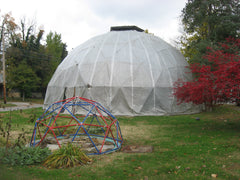
He was a fascinating character and full of amazing ideas, check out this animated interview to get a bit more of a sense of his thinking. This picture shows Buckminster Fuller's own dome house!
(General Wikipedia summary is here)
Unique structural benefits of geodesic domes
Geodesic domes are loved for their extraordinary structural benefits. The triangles provide remarkable strength, distributing stress evenly across the structure, and the geometry allows for lightweight yet incredibly sturdy construction, capable of withstanding severe weather conditions, including strong winds and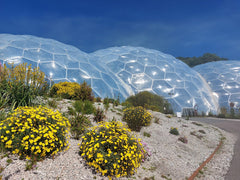 heavy snowfall.
heavy snowfall.
The spherical form also enables the wind to pass over and around the structure, reducing its drag versus more typical building shapes. There is also no need for internal support; this creates a great sense of space with unobscured views in every direction – if you’ve been to the Eden Project, you’ll know exactly what we mean here, the sense of space is amazing! These unique qualities make geodesic domes a great option for a range of applications, from residential to educational and recreational.
Environmental advantages
Geodesic domes deliver quite a few environmental advantages. The dome's form maximises interior space while minimising external surface area.
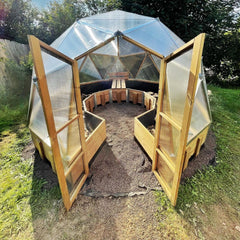
This leads to a reduction in the materials used in construction, which can lead to a lower construction carbon footprint and reduced waste.
The ratio of interior space to the external surface area also helps with efficient temperature regulation and encourages air circulation, and the shape is also great for natural light. Together these reduce the need for artificial lighting and climate control, which can lead to energy savings, another eco-friendly plus point of geodesic domes. So geodesic domes are not only architecturally sound but also energy-efficient, a great advantage in today's environmentally conscious world.
Versatility of geodesic domes
Geodesic domes are remarkably versatile, serving a multitude of purposes.
They make striking living spaces, creating unique and sustainable houses. In educational settings, they provide innovative, engaging environments for learning and exploration. For recreational use, domes can be transformed into greenhouses, garden rooms, and cosy retreats. They are also great for temporary installations like event venues or emergency shelters. You’ll also see them crop up quite a lot in sci-fi, quite a common feature on spaceships and a form of choice for moon bases!
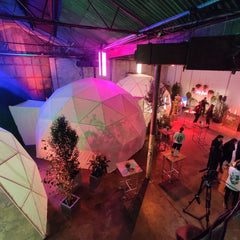
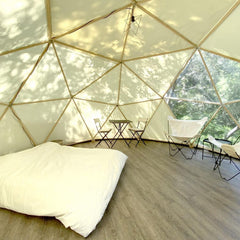
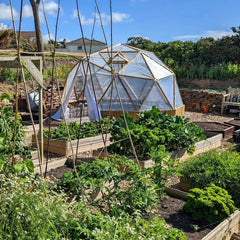



Ease of construction with build with hubs kits
Domes are typically tricky to build. The maths is tricky, and then the angles at each joint are really tricky to make physically. So unless you are a master craftsman it’s very hard to make one. And even if you find someone who can, it’ll be very expensive. That’s where our kits come in. Our hubs make the hard part, the joints, easy, making building a dome remarkably simple, and accessible to everyone. Even those with minimal building experience can construct a dome easily. In fact you probably don’t need any building experience to build a dome with hubs! By working with readily available wood, they are inexpensive to build too. All you need to do is cut two lengths of the stick (our calculator will tell you the lengths!) and you are ready to go.
We’ve spent a lot of time thinking through the process of making the dome, creating comprehensive instructions that explain it as simply as we can, to make the assembly process as hassle-free as possible. The intuitive snap-together hubs are very satisfying to connect - building the dome is actually quite a lot of fun! The hubs themselves are made with high quality, durable automotive grade UV stabilised plastic, with stainless steel metal parts to secure them in place. They are designed to last a long time in the great outdoors.
If you want to make your own dome, whether it’s a greenhouse, fruit cage, kid’s den, chicken run, tree house, pool cover, observatory, shed, an artwork or a set for theatre production, then our kit can help you realise your idea.
Need a bit of inspiration? Check out all the other people who have made domes with hubs, then explore various kit options and buy directly!

